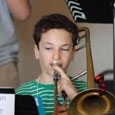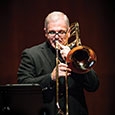At least once a year I receive a call or email from a band director asking if I have a tuning tendency chart for trombone, euphonium, or tuba. The director is usually looking for some version of a chromatic fingering chart that shows tendencies of individual notes, but I always respond by sending a harmonic series chart with tuning tendencies indicated for each partial rather than each note. The reason for this is simple: while particular instruments will have a few quirky notes that depart from the norm, as a rule all the notes in each partial will behave in the same way. Furthermore, the tuning tendencies of the different partials are the same for all brass instruments. Understanding the harmonic series and how it applies to each brass instrument might seem complicated at first, but once understood it is a tremendous shortcut to finding fingerings (particularly alternate fingerings) and tuning tendencies on all of the brasses.
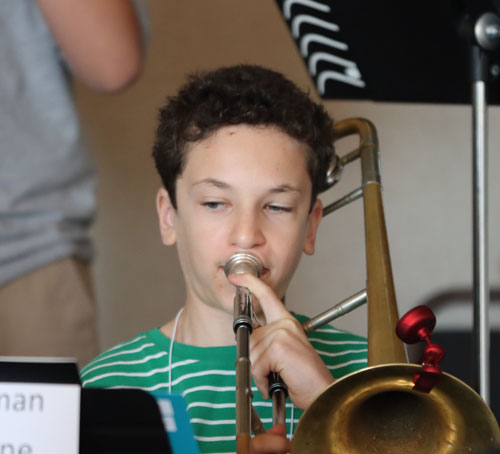
photo by Kirby Fong
Basic Acoustic Principles
The terms harmonic series and overtone series refer (interchangeably, if imprecisely, in brass players’ parlance) to the principle in acoustics in which musical sounds (or any sounds really) are understood to be complex tones consisting of vibrations not only at a certain fundamental pitch level but also constituent vibrations at certain mathematically expressed levels above that pitch. The mathematical formulas undergirding all of this are fascinating, but thoroughly understanding them is not necessary for successfully applying the concept to brass playing and teaching.
For our purposes we need first of all to understand that each brass instrument is built with its open bugle the precise length needed to produce a certain fundamental pitch. For example, the Bb trumpet’s main tubing is a little over 4.5 feet in length, yielding a fundamental pitch of concert Bb2 (116.54Hz), while that of the F horn (and the F tuba, incidentally) is around 12 feet, yielding a fundamental pitch of concert F1 (43.65Hz). By the way, brass instruments are named according to their open fundamental tones (in concert pitch), not necessarily according to the usual transposition (or lack thereof) of their sheet music. Thus, for example, a BBb tuba is so called because its open fundamental pitch is BBb (or Bb0) despite its music normally being written in concert pitch. Depressing valves or extending the trombone’s handslide lengthens the instrument, thereby progressively lowering its fundamental pitch.
If the fundamental pitches of each tubing length were the only ones available, brass players would be limited to a small range of notes, indeed. Additional notes above the fundamental are produced by overblowing to the higher partials of the harmonic series for each valve combination or slide position. The acoustic properties of brass instruments are such that the instrument will produce a resonant sound as long as the pitch buzzed by the player is a part of the harmonic series for the slide position or valve combination then in use.
This means that instead of having only one note per fingering or slide position, players can produce many notes in that fingering’s harmonic series, limited only by the qualities of their embouchures, airflow, and audiation. The most advanced players can often learn to play to the 20th partial or higher. Good high school players will be able to reach at least the eighth (usually higher for horn); beginners can be expected to reach the fifth or sixth by the end of the first year, although few will be able to produce the fundamental at that point.
Finding Fingerings
The foregoing discussion is oversimplified but provides a sufficient, basic introduction to the topic. More important is understanding how the harmonic series is of practical benefit to music teachers in the field. The primary benefits are the ability to quickly and easily find fingering possibilities on every brass instrument and the ability to anticipate the likely tuning tendencies of a given note in a given fingering combination.
Concerning fingerings (or slide positions), consider this abbreviated harmonic series chart, containing the first eight partials in the seven main slide positions on the trombone.
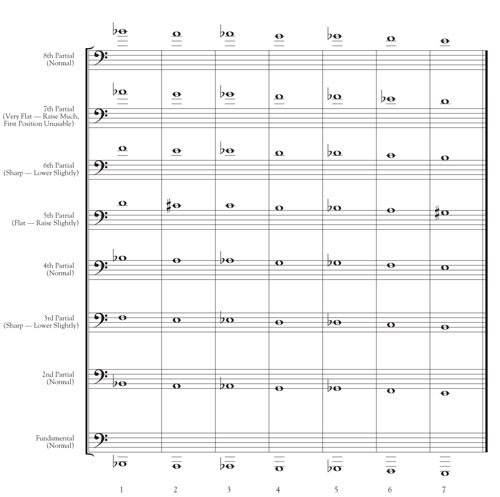
Some of the notes on this chart occur multiple times in various slide positions. That will become relevant later, but consider first only the notes in first position. The first partial or fundamental is Bb1, which is commonly called pedal Bb. The next note is Bb2, one octave higher, then F3, Bb3, D4, F4, Ab4, and Bb4. Thus, moving up the harmonic series from the fundamental or pedal we have an octave, a perfect fifth, a perfect fourth, a major third, a minor third, another minor third, and then a major second.
For the succeeding slide positions, the whole thing moves down chromatically, one half-step for each slide position. In practice, after memorizing the first eight partials in first position, it is possible to extrapolate from that and figure out the available notes in every other position.
This approach to finding fingerings works on every brass instrument. The same sequence of intervals applies, starting with the fundamental. If you were to memorize only the open fundamental pitch of every brass instrument, you could find from there the open or first position harmonic series, then in turn those for the other fingerings. Memorize just the open harmonic series and the number of steps needed for finding fingerings is even smaller. With time, memorizing a large portion of each instrument’s harmonic series chart is simple.
Most notes have two or more possible fingerings, and the number of possibilities increases as you move higher in the range. Although there are exceptions, as a general rule, the preferred fingering for a given note is usually the one furthest to the left on the chart – in other words, the one that is closest to open or first position.
Finding Tuning Tendencies
Understanding the harmonic series makes it possible to anticipate and compensate for possible tuning issues. Consider again just the first position harmonic series from the chart we just examined, particularly the intonation indications just to the left of each staff. (Figure 2) You will notice that the fundamental and its octaves are normally true to pitch, while the third and sixth partials (also an octave apart) tend to be somewhat sharp. The fifth partial is normally flat, while the seventh is so flat that it is normally unusable on valved brass instruments and can only be used on trombone beginning in second position – and then only with a substantial correction. The eleventh partial is similarly unusable, as are a number of even higher partials, but the seventh is the one most likely to be a problem for secondary school-aged students.
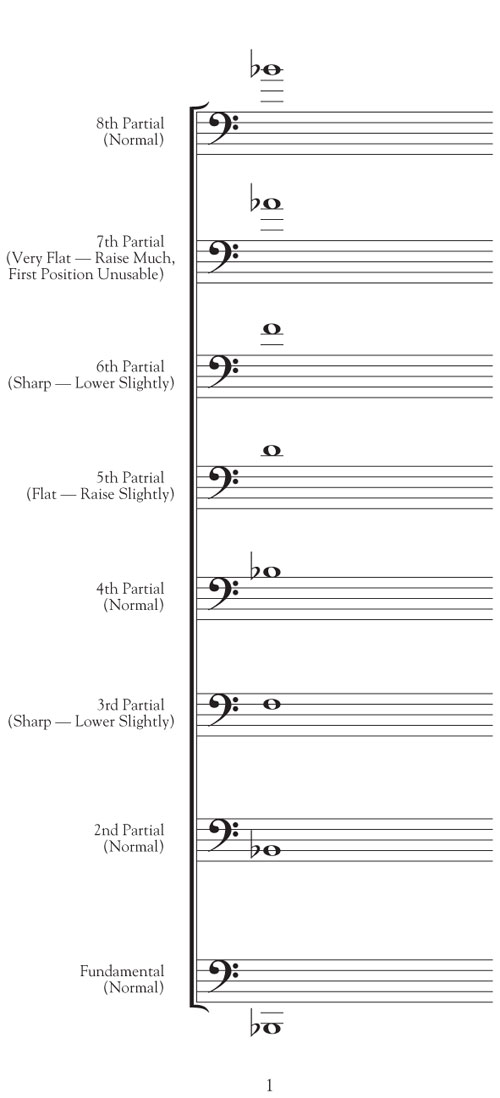
Not only is the sequence of intervals in the harmonic series the same for every brass instrument, but the tuning tendencies of each partial are the same on every instrument. Moreover, octaves within the harmonic series have the same tendencies, so the first, second, fourth, and eighth partials tend to be true to pitch, while the third, sixth, and twelfth will be sharp, and the fifth and tenth will be flat. If you memorize the harmonic series and the tuning tendencies of the different partials you will not only be able to find fingerings for your students, but also be able also to solve intonation problems by selecting alternate fingerings that will raise or lower the pitch as needed.
Harmonic series charts might seem imposing and mysterious at first, especially for non-brass players. However, the system is logical, and these acoustic and functional principles are the key to understanding how brass instruments work. By memorizing a relatively small amount of material and understanding how to apply these patterns on every brass instrument, you will readily find fingerings, anticipate tuning tendencies, and suggest alternatives to correct difficulties with both pitch and technique.
